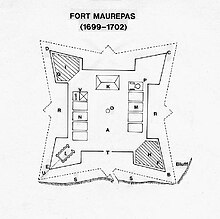Fort Maurepas
Fort Maurepas, later known as Old Biloxi,[1] was developed in colonial French Louisiana (New France) in April 1699 along the Gulf of Mexico (at present-day Ocean Springs, Mississippi).
[3] The fort was completed on May 1, 1699[1][2] under direction of French explorer Pierre Le Moyne d'Iberville, who sailed for France on May 4.
[2] He returned from his river journey on April 1, and spent another week in searching the shores adjacent to Ship Island, where the fleet had been anchored.
[6] The expedition journal reported:[2] In the meantime, the boats were actively engaged transporting the powder, guns, and ammunition, as well as the live stock, such as bulls, cows, hogs, fowls, turkeys, etc.
The fort was made with four bastions, two of them squared logs, from 2-3 feet [1 m] thick, placed one upon the other, with embrasures for port holes, and a ditch all around.
Twelve guns were mounted.The best men were selected to remain at the fort,[2] including detachments of soldiers to place with the Canadians (the French also had a colony in what is now Quebec and along the upper Mississippi River) and workmen, and sailors to serve on the gunboats.
On the return of d'Iberville to Old Biloxi in January 1700, he brought with him sixty Canadian immigrants and a large supply of provisions and stores.
He carried a request from the French minister to the governor M. de Sauvolle, asking that Sagan be furnished with 24 pirogues and 100 Canadians in order to explore the Missouri River and its branches, a major tributary of the Mississippi that has its confluence at what later developed as Saint Louis.
[2] On September 16, 1700, a party of Choctaw warriors arrived at Biloxi, asking for French troops to help them fight against the Chickasaw, their traditional enemies among native groups.
On January 5, 1702, Bienville departed for the Mobile River, leaving 20 men under the command of M. de Boisbriant as garrison at the fort.
At Dauphin Island, Bienville met with his brothers de Serigny and Chateaugue, who had arrived with a detachment of sailors and workmen.
[7] In 1719, the administrative capital of French Louisiana was moved to Old Biloxi from Mobile (or Mobille), during the War of the Quadruple Alliance (1718–1720) against Spain.
[7] Later, during June–August 1722, the capital was moved again, by colonial governor Bienville, from Biloxi to deeper waters in the Mississippi River at a new inland harbor town named La Nouvelle-Orléans (New Orleans), built for the purpose during 1718-1722.
It was badly damaged by Hurricane Katrina in August 2005, when all coastal areas of Mississippi were devastated by a storm tide exceeding 30 feet (9 m), with waves even higher.
A replica of the wooden Fort Maurepas was built on front beach about a mile from the original site (which is on private property) in the 20th century and was open to the public.
It was badly damaged by Hurricane Katrina on August 29, 2005, when coastal Mississippi was devastated by a storm surge exceeding 30 feet (9 m) plus higher waves.
It includes a playground, a splash pad, a stage, a two-story structure with a viewing platform overlooking the beach, public restrooms, and an eco-friendly parking lot.



